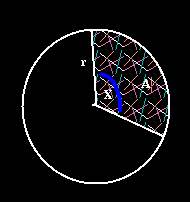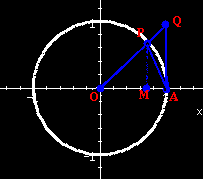
The Squeeze Theorem Applied to Useful Trig Limits
Suggested Prerequesites:
The Squeeze Theorem,
An Introduction to Trig
There are several useful trigonometric limits that are necessary for
eveluating the derivatives of trigonometric functions. Let's start by
stating some (hopefully) obvious limits:
|
|
| |
| |
Since each of the above functions is continuous about x = 0,
the value the limit at x = 0 is the value of the function at
x= 0. This follows from the definition of
limits.
In order to evaluate the derivatives of
sin and
cosine we need to evaluate
and
In order to do this, need the following theorem of geometry:
 |
If x is the measure of the central
angle of a circle of radius r, then the area A of
the sector determined by x is
A = r2x/2 |
Let's start by looking at .
 |
If , then we have the situation in the figure to the left.
Assume the circle is a unit circle, defined by x = cos
t, y = sin t. |
 If A1 is the area of the triangle AOP,
A2 is the area of the circular sector
AOP, and A3 is the area of the triangle
AOQ,
If A1 is the area of the triangle AOP,
A2 is the area of the circular sector
AOP, and A3 is the area of the triangle
AOQ,
A1 < A2 <
A3.
The area of a triangle equals one half the base times the height. Using
this, and the above theorem for the area of a sector of a circle, we
obtain:
|
|
|
|
|
|
| Thus: |
|
We divide by
and use the fact that tan x = sin x / cos
x:
which is equivalent to
Now, what about , which is the same as ,
then
which reduced to the previous inequality.
Now, since
and
by the Squeeze Theorem is must be true that
What about
? Well, we do some algebraic manipulatons:
| |
|
|
|
|
|
| |
|
Therefore:
| |
|
|
|
|
|
To summarize the results of this page:
Back to the Calculus page |
Back to the World Web Math top page
jjnichol@mit.edu




 If A1 is the area of the triangle AOP,
A2 is the area of the circular sector
AOP, and A3 is the area of the triangle
AOQ,
If A1 is the area of the triangle AOP,
A2 is the area of the circular sector
AOP, and A3 is the area of the triangle
AOQ,